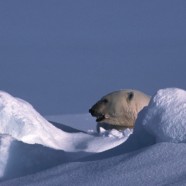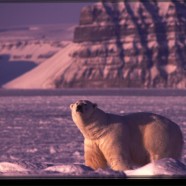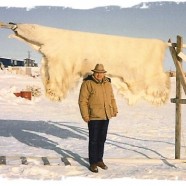Arctic: Keep it In My Backyard (KIMBY)
The Arctic Council is meeting this week in Kiruna Sweden an appropriately choice for the venue considering that mans’ impacts on the Arctic climate will be high on the agenda. Kiruna hosts the largest underground iron mine in the world where in response to ground deformations caused by mining, the city will be relocated over the coming years. Later this week at Kiruna the eight Arctic States (Russia, Finland, Denmark for Greenland, Sweden, Norway, Iceland, the U.S. and Canada) will sign a ‘Marine Oil Pollution Preparedness and Response’ agreement. The agreement aims to strengthen cooperation, coordination and mutual assistance on pollution preparedness and response in the Arctic in order to protect the marine environment from pollution by oil. Despite this noble promise the agreement does little more than reinforce existing international agreements.
CITES : Vote blank !
Convention on International Trade in Endangered Species of Wild Fauna and Flora
CITES 2013 – Bangkok, 7.00 pm (local time)
Press release # 6
The United States, Russia, and the European Union take plenary session this week for the 16th CITES assembly. “A joint proposition for polar bears!” such is Robin des Bois’ message for Bangkok.
This new, last resort proposal could ban international polar bear trade concerning eight declining subpopulations. It would be less restrictive than the Appendix-I ban on international trade for all polar bears, and would therefore be more likely to collect more votes than the initial proposal by the United States. The decline of some subpopulations is recognized by all, including Canada. In 1991, Canada regarded the fate of polar bears as something which raised serious concerns. Polar bears in the western part of the Hudson Bay are especially targeted.
“Le Beau Mâle,” the perfume that kills
An advertisement for John Paul Gaultier’s new perfume portrays a handsome man with the remains of a polar bear.
Polar bears are at risk of extinction. Hunting is specifically aimed at males. Polar bears are also threatened by the chemical contamination of the Arctic, noise pollution, food scarcity and climatic disturbances.
Of course the authenticity of these polar bear parts for advertising purposes is not guaranteed. But this image encourages a belief in the virtues of charm and virility associated with animal trophies. As CITES – the Convention on International Trade in Endangered Species of Wild Fauna and Flora – has just refused the proposal to transfer polar bears into Appendix I (1), this advertising is poorly timed.
International Trade of Polar Bears to Continue
Convention on International Trade in Endangered Species of Wild Fauna and Flora
CITES 2013 – Bangkok, 12h50 (local time)
Press Release No. 3
The international community, inadequate in stopping the melting of the ice caps, is equally inadequate in protecting polar bears from international trade. The U.S. proposal to add polar bears to Appendix I of CITES was voted down yesterday with only 38 votes for, 42 against, and 46 abstentions (2/3 of the vote were necessary).
The agreement between the U.S. and Russia was not enough. The 27 members of the European Union abstained; they are well situated among the 70 countries that import polar bear hides and skulls each year.
Polar Bears Betrayed by the European Union
In Doha, Qatar in 2010, Europe played a deciding role in the rejection of the American proposal to add Ursus maritimus to Appendix I. Because Europe voted against it, the proposal failed.
In Bangkok, three years later, the E.U. tries again to block the U.S. proposal. Instead of supporting the U.S. proposal, like Russia, the E.U. proposes keeping the polar bear under Appendix II, which authorises the international trade of polar bears and their parts. This compromise suggested by the E.U. is actually more like the status quo. The E.U. presented its proposal several requirements already expressed by specialists, environmental NGOs and certain range states, claiming it would be best to first understand the state of sub-populations, investigate smuggling networks, and to evaluate the effects of the capture and the hunting of the species.
Is Coca Cola in favour of Polar Bear trade ?
Chairman of the Board and Chief Executive Officer
The Coca-Cola Company
One Coca-Cola Plaza
Atlanta, Georgia 30313
Dear Mr. Chairman Kent,
Robin des Bois is an NGO working for the protection of Man and Environment, based in Paris and has been an observer at CITES, (Convention on International Trade in Endangered Species of Wild Fauna and Flora) since 1988. Fear not, we are not asking for money, we are simply writing to you today with the hope of receiving a response.
We are well aware of the deep-seeded affection your company expresses for polar bears and your interest in their future. With this in mind Coca Cola has established a scientific and economic partnership with WWF. This partnership has raised millions of dollars with the goal of reinforcing efforts towards the protection of polar bears.
A Dark Future for Polar Bears
The hunting of polar bears is now in full force. The Canadian tourist agencies responsible for organizing hunting trips in Nunavut, the North West Territories, and in Manitoba are completely booked until 2014. In order to respond to such high demand, Nunavut increased the hunting quotas in the Hudson Bay area, without taking into account the disapproval of the Polar Bear Specialist Group from the IUCN (International Union for the Conservation of Nature). Instead of the elephant, the polar bear is now the « ultimate target ». The polar bear finds itself in the challenge of the century, at the summit of the world. « For our European Clients, we recommend at least the caliber 8 x 57mm, but the best is 9.3 x 74mm ». Having reached the top, you can return with the most prestigious of trophies, with some help from the best taxidermists in Canada.
Polar Bears: Left Out in the Cold
The polar bear (Ursus maritimus) is a marine mammal that lives off of the other marine mammals inhabiting the artic ice pack, and the surrounding ice flows and ocean. The polar bear is thus an excellent swimmer. The artic ice pack, home of the polar bear, is disappearing. The vulnerability and mortal risks faced by polar bears are increasing.
The polar bear, beloved by many, has become the martyr employed by governments and NGOs to symbolize the fight against global warming. It has become a fundraising symbol and a top-model.















